Physical Address
304 North Cardinal St.
Dorchester Center, MA 02124
Most gait disturbances are benign and resolve with normal growth and development. Others are pathologic in origin and necessitate treatment ( Table 45.1 ).
| Mechanical |
|
| Osseous |
|
| Articular |
|
| Neurologic |
|
| Hematologic/Oncologic |
|
| Other |
|
The normal gait cycle is described by foot placement. The gait cycle begins with right heel strike; is followed by left toe-off, left heel strike, and right toe-off; and ends with right heel strike. These five events describe one gait cycle and include two phases: stance and swing. The stance phase is the period of time during which one of the two feet is on the ground. The swing phase is the period during which a limb is being advanced forward without ground contact.
Measuring the duration of the gait cycle makes it possible to calculate the time required for each of the five phases. During normal gait, the duration of each phase is as follows: for weight acceptance, 11%; for single limb stance, 39%; for weight release, 11%; and for swing phase, 39%. Velocity, cadence, step length, stride length, and step width may be calculated from the timed and measured gait cycle.
Central nervous system maturation is necessary for the development of normal gait and accounts for the normal progression of developmental milestones. The typical milestones for locomotion include independent sitting at 6 months of age, crawling at about 9 months, walking without assistance at 12–15 months, and running at 18 months. A normal 1-year-old child has a wide-based stance and a rapid cadence with short steps; the elbows are flexed and reciprocal arm motion is not present. Foot strike occurs without an initial heel strike. A 2-year-old child shows increased velocity, step length, and diminished cadence in comparison with a 1-year-old child. Most of the adult gait patterns are present in children by 3 years, with changes in velocity, stride, and cadence continuing to 7 years of age. The gait characteristics of a 7-year-old child are similar to those of an adult.
The clinician should inquire about the pregnancy and delivery, the age at which developmental milestones occurred, the presence of any systemic illnesses (including chronicity, fever, rash, weight loss, and other organ system involvement), and whether there is a family history of any congenital musculoskeletal abnormalities or syndromes. With regard to the gait disturbance, it is important to inquire when it was first observed, whether it is unilateral or bilateral, whether it is associated with any injuries or intercurrent systemic illnesses, if there is associated pain or weakness, and whether there has been a history of improvement or worsening with time.
Although most of the findings in gait disturbances are confined to the lower extremities, the upper extremities and spine may be involved as part of an underlying disease process. A general assessment of all extremities and the spine should be performed to identify any abnormal motion, tenderness, swelling, deformity, or increased warmth.
The lower extremity musculoskeletal examination should begin with the child ambulating in the examination room or adjacent hallway. The child must be adequately undressed and be observed from a distance while walking so that the trunk and lower extremities can be clearly visualized. The positions of the thighs, knees, lower legs, and feet should be observed during ambulation. Combining gait observation with the history typically allows for diagnosing most of the common gait disturbances such as torsional variations (in-toeing and out-toeing), equinus gait (toe-walking), and limping.
Examination of the lower extremities should include measurement of lower extremity lengths and assessment of the hip, knee, ankle, and subtalar joints. The thighs, lower legs, and feet are inspected for evidence of asymmetry, soft tissue swelling, or injury. Palpation for tenderness or areas of increased warmth is performed. The shape of the foot is assessed for possible intrinsic deformity.
The most accurate method of measuring lower extremity length is with radiographs; however, if radiographs are not readily available, this assessment is best performed by having the child stand on a firm, level surface with the examiner standing behind the child and placing index fingers over the lateral aspect of each of the child’s iliac crests. The presence or absence of pelvic obliquity is observed, and blocks of various heights are placed beneath the child’s foot on the short side until the pelvis is level. The height of the blocks indicates the amount of lower extremity length discrepancy. Measurements obtained by use of a tape measure can also be performed but are less accurate. The most common measurements using this method are from the anterior-superior iliac spine to the distal aspect of the medial malleolus. These landmarks are sometimes difficult to palpate accurately, and there can be considerable error using this method. The Galeazzi test can assess for femoral or tibial length discrepancy or hip dislocation leading to a perceived limb length disturbance ( Fig. 45.1 ). Tibial length can also be assessed by having the patient in a prone position and knees flexed to 90 degrees and then observing the relative height of the feet.
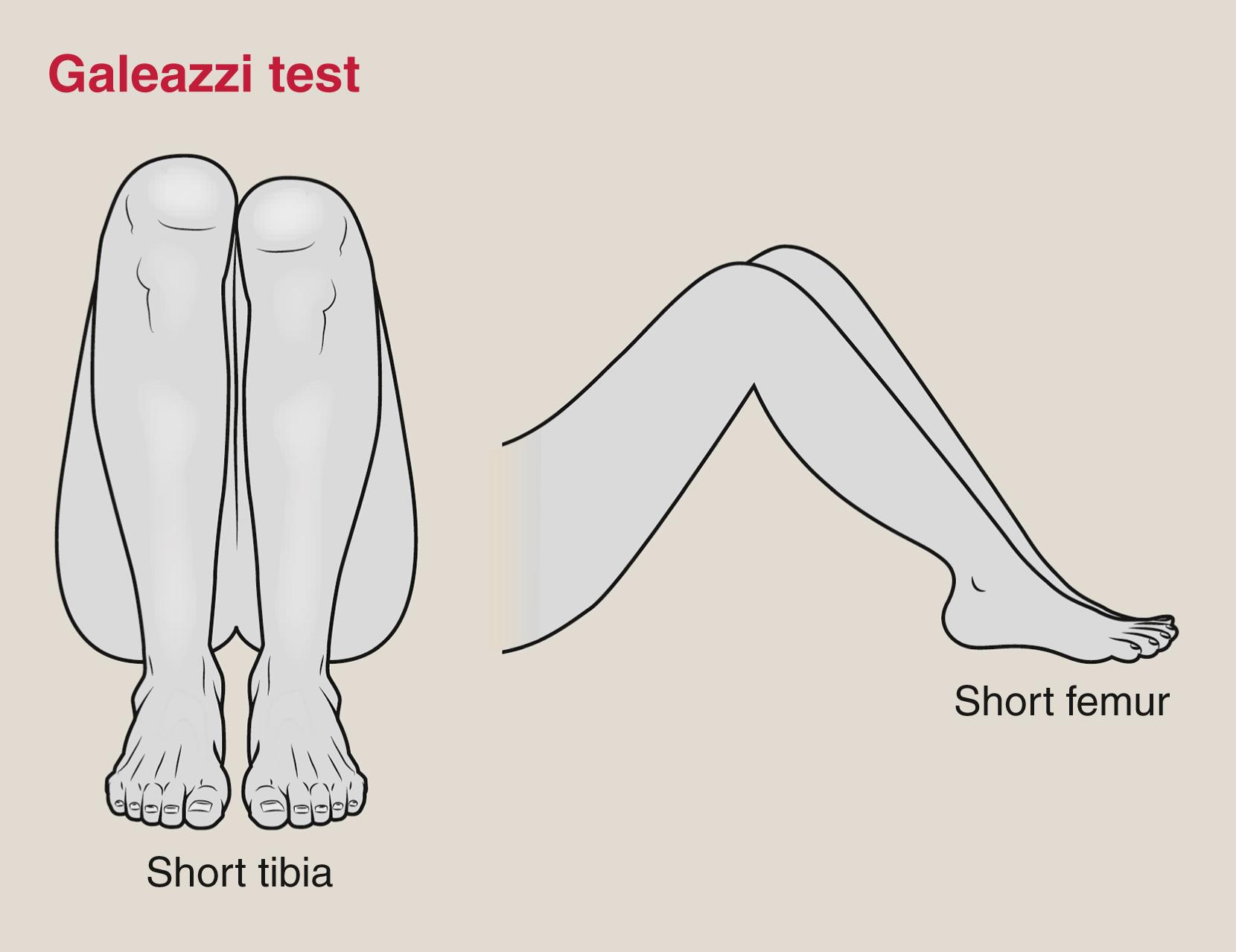
The ranges of motion of the hips, knees, ankles, and subtalar joints must be assessed. Hip flexion is measured, as are any flexion contractures. With the hip in extension, the degrees of abduction, adduction, internal rotation, and external rotation are measured, preferably with a goniometer, and are recorded. Hip rotation is most accurately measured with the child in the prone position with the knees flexed. Older children and adolescents are typically more comfortable when measured in the supine position with hips and knees flexed to 90 degrees. Knee flexion and extension, ankle dorsiflexion, and plantar flexion, as well as subtalar motion, must be assessed and recorded.
Spinal mobility should be assessed because abnormalities such as spondylolysis, nerve root impingement, diskitis, and tumors may manifest as a gait disturbance. The child’s ability to flex forward and to reverse lumbar lordosis is a sign of normal mobility (see Chapter 46 ). Areas of vertebral bone tenderness and muscle spasm are determined by direct palpation.
Many gait disturbances have a neurologic cause or association. The neurologic examination should include assessment of unilateral or bilateral involvement, the presence of paresthesia, and muscle strength testing, sensory assessment (particularly to establish the specific level or distribution of any potential sensory deficits), deep tendon reflexes, and pathologic reflexes, such as the Babinski sign. Abnormal rectal tone or bladder distention is concerning for a spinal lesion.
The need for radiographic evaluation is based on the differential diagnosis. For many gait disturbances, radiographic assessment is not required. When necessary, plain radiographs of the lower extremities, pelvis, or spine are obtained first, followed by special diagnostic studies, such as anteroposterior (AP) leg length radiographs to assess for discrepancy, technetium bone scan to localize occult lesions such as avascular necrosis or stress fracture, and CT to characterize specific lesions. MRI is helpful in the diagnosis of occult or soft tissue lesions, such as infection, tumors, or metabolic bone disease, as well as other pathologic structural processes of the spine, such as syrinx, tethered cord, or disk anomaly.
Tests such as CBC with differential, ESR, and CRP level are indicated if an infectious, rheumatic, or otherwise inflammatory condition is suspected. Rheumatoid factor and antinuclear antibody determinations are less helpful in the diagnosis of rheumatic causes of gait disturbances (see Chapter 44 ). Other tests may be indicated for the diagnosis of specific disorders. Electromyography, nerve conduction studies, muscle biopsies, and nerve biopsies are frequently necessary in the diagnosis of myopathic or neuropathic disorders (see Chapter 35 ). Determinations of creatine phosphokinase, aldolase, and aspartate aminotransferase levels are important in the evaluation of striated muscle function and should be ordered if an underlying myopathy or myositis is suspected.
The three most common categories of gait disturbances of childhood are torsional variations (in-toeing and out-toeing), toe-walking (equinus gait), and limping.
The presence of in-toeing or out-toeing does not necessarily imply an abnormality of the foot; rather, it indicates only the direction in which the foot is pointing during ambulation. Torsional variations can be located from the proximal (i.e., the hip) to the distal (i.e., the foot) region in the involved extremity. Some causes, such as clubfeet, are obvious, whereas others are subtle. Most torsional variations resolve with normal growth and development. The common causes of in-toeing and out-toeing are listed in Table 45.2 .
| In-Toeing | Out-Toeing |
|---|---|
| Medial (internal) femoral torsion | Lateral (external) femoral torsion |
| Medial (internal) tibial torsion | Lateral (external) tibial torsion |
| Metatarsus adductus | Calcaneovalgus feet |
| Talipes equinovarus (clubfoot) | Hypermobile pes planus |
In utero positioning affects the alignment of the lower extremities of infants. In the typical in utero position, the hips are flexed, abducted, and externally rotated; the knees are flexed; and the lower legs are internally rotated. The feet are in a supinated position against the posterolateral aspect of the opposite thigh. The musculoskeletal examination of an infant characteristically shows 20- to 30-degree hip flexion contractures, 50–60 degrees of abduction, 80–90 degrees of external rotation in extension, and minimal or no internal rotation. The knees have 20- to 30-degree flexion contractures, and internal tibial torsion is present. These are normal findings. The increased external rotation of the hip is caused not by femoral retroversion but rather by a posterior hip capsule contracture, which begins to resolve at the time of independent ambulation.
The combination of external rotation at the hip and internal rotation of the lower leg results in physiologic genu varum , a bowed appearance of the lower extremities, particularly when in the weight-bearing position, that reflects this physiologic torsional combination. After the child attains independent ambulation, this bowed appearance improves over a 6- to 12-month period with expected resolution by 2 years of age in over 95% of children. Exaggerated bowing under the age of 2 years, failure to progress through the anticipated developmental stages of limb alignment, asymmetry, pain, or deformity isolated to the tibia may be signs of pathologic genu varum warranting further evaluation; the primary differential diagnosis of pathologic genu varum consists of tibia vara ( Blount disease ), rickets and other metabolic bone diseases, and asymmetric growth following infection or trauma or in the setting of benign or malignant neoplasms. Initial evaluation typically consists of anteroposterior radiographs of the bilateral lower extremities with the knees moved into a forward-facing position so as to minimize confounding from external rotation at the knees. Tibia vara is characterized by pathologic disruption of growth at the medial aspect of the proximal tibial physis and may be described as infantile (presentation prior to age 4 years) or adolescent (presentation in later childhood or adolescence); infantile tibia vara is more often bilateral, whereas adolescent disease may be either unilateral or bilateral. In addition to bowing, gait observation may reveal varus thrust , which consists of sudden lateral movement of the knee during the stance phase. In tibia vara, the anteroposterior radiographs of the bilateral lower extremities with the knees in a forward-facing position reveal medial beaking and downward sloping of the proximal tibia metaphysis. Patients with rickets often have short stature and may additionally present with pathologic fractures. Bone density may be decreased on radiography, though bone mineralization may appear normal as well; patients with severe rickets may have widened and cupped physes and flared metaphyses. Initial serum evaluation of rickets consists of determining levels of parathyroid hormone, calcium, and inorganic phosphorus concentrations; investigations for underlying liver or kidney disease should be undertaken as well. Congenital pseudoarthrosis of the tibia and congenital pseudoarthrosis of the fibula are very rare forms of angular deformity of the lower extremity that result in bowing; pathogenesis is believed to be related to abnormalities of the periosteum. Both are associated with neurofibromatosis type 1. Affected patients typically present not with a pseudoarthrosis, but with anterolateral bowing of the lower leg that is noted at birth. Rather, pseudoarthroses typically arise following pathologic fracture and subsequent nonunion of the affected bone, usually after the patient begins ambulating. Despite aggressive surgical management, nonunion and progressive deformity may persist.
Physiologic or developmental genu valgum (“knock knees”) is seen between 3 and 4 years of age. This is true genu valgum, an angular phenomenon, and is not the result of torsional variations. This condition resolves with growth and normal adult knee alignment is obtained between 5 and 8 years of age. Newborns have a mean varus alignment of 15 degrees that corrects to neutral alignment between 18 and 20 months of age. The maximum valgus of 12 degrees occurs by 3–4 years of age. By 7 years of age, the valgus alignment corrects to that of a normal adult (8 degrees in females, 7 degrees in males). Overall, 95% of cases of developmental genu valgum resolve with growth, even in children with more pronounced findings. In some children, the condition may not completely correct until adolescence or may resolve incompletely; in the absence of known trauma or underlying metabolic disease, short stature, or infection, persistent bilaterally symmetric genu valgum is considered idiopathic. The differential diagnosis of nonidiopathic, bilaterally symmetric genu valgum includes rickets, other metabolic diseases such as mucopolysaccharidosis, and skeletal dysplasias. Pathologic genu valgum may also be unilateral; unilateral valgus deformity is often secondary to previous trauma, such as a nondisplaced tibial metaphyseal fracture. Other etiologies include post-traumatic or postinfectious partial physeal arrest; conditions associated with benign neoplasms, such as Ollier disease (multiple enchondromas) or multiple hereditary exostosis; or asymmetric manifestations of metabolic disease or skeletal dysplasia.
The torsional or rotational profile aids in the diagnosis and sequential follow-up of children with torsional variations ( Fig. 45.2 ).
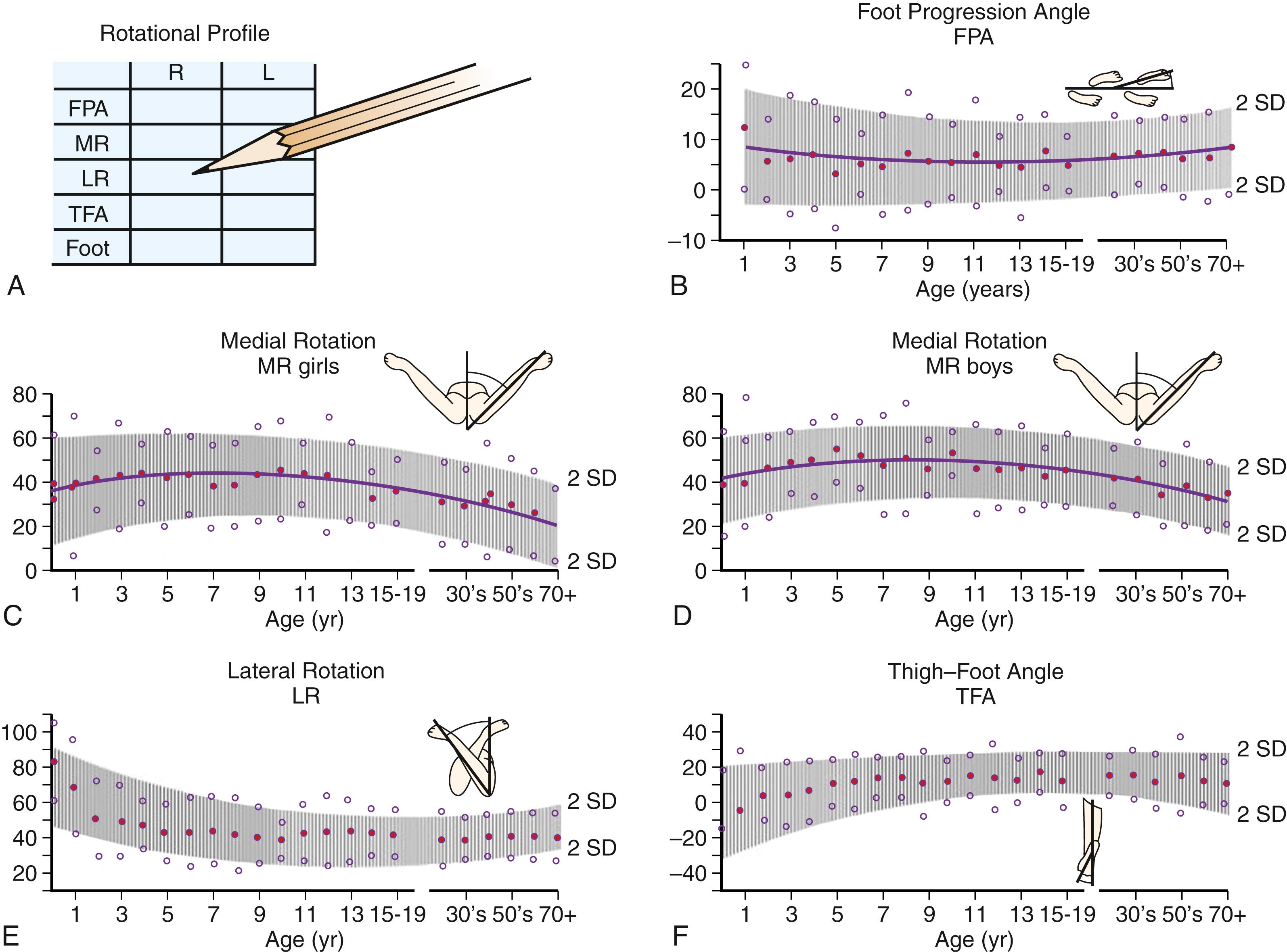
The foot progression angle, which is the direction of the long axis of the foot with regard to the direction in which the child is walking ( Fig. 45.3 ), should be measured. Inward rotation is given a negative value and outward rotation a positive value. A normal foot progression angle in children and adolescents is 10 degrees (range, −3 to +20 degrees). The foot progression angle defines whether the gait is normal or if there is an in-toeing or out-toeing gait. Recording the angle allows for comparison during follow-up evaluations.
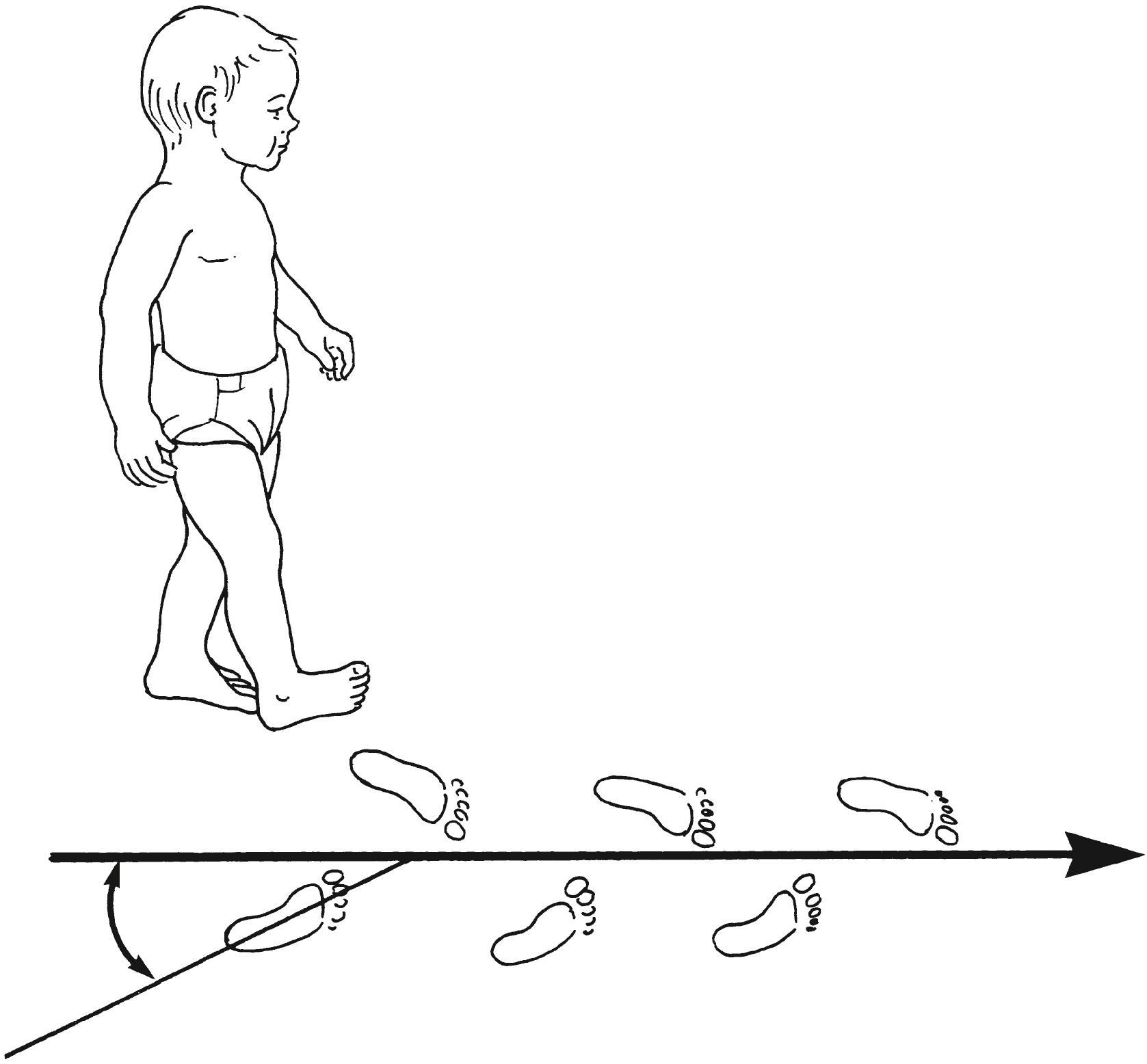
Measuring hip rotation allows for indirect assessment of femoral version. Typically, the femoral neck creates an anteriorly directed angle with the transcondylar axis of the distal femur ( Fig. 45.4 ). This anterior angulation is known as femoral anteversion and decreases from approximately 40 degrees at birth to 15 degrees by maturity. Increased internal rotation at the hip indicates excessive anteversion; increased external rotation at the hip indicates retroversion. Hip rotation is assessed with the child in the prone position with the knees together and flexed 90 degrees ( Fig. 45.5 ). In this position, the hip is in neutral alignment. Rotating the lower leg outwardly produces internal rotation of the hip; rotating the lower leg inwardly produces external rotation of the hip. A newborn hip in extension typically rotates externally 80–90 degrees and has a limited internal rotation of 0–10 degrees. By 1 year of age, there is approximately 30–40 degrees of internal rotation. Hip rotation should be bilaterally symmetric. Asymmetric rotation is often indicative of a hip disorder and necessitates radiographs of the pelvis. The mean hip internal rotation in extension in older males is 50 degrees (range, 25–65 degrees), and that in females is 40 degrees (range, 15–60 degrees).
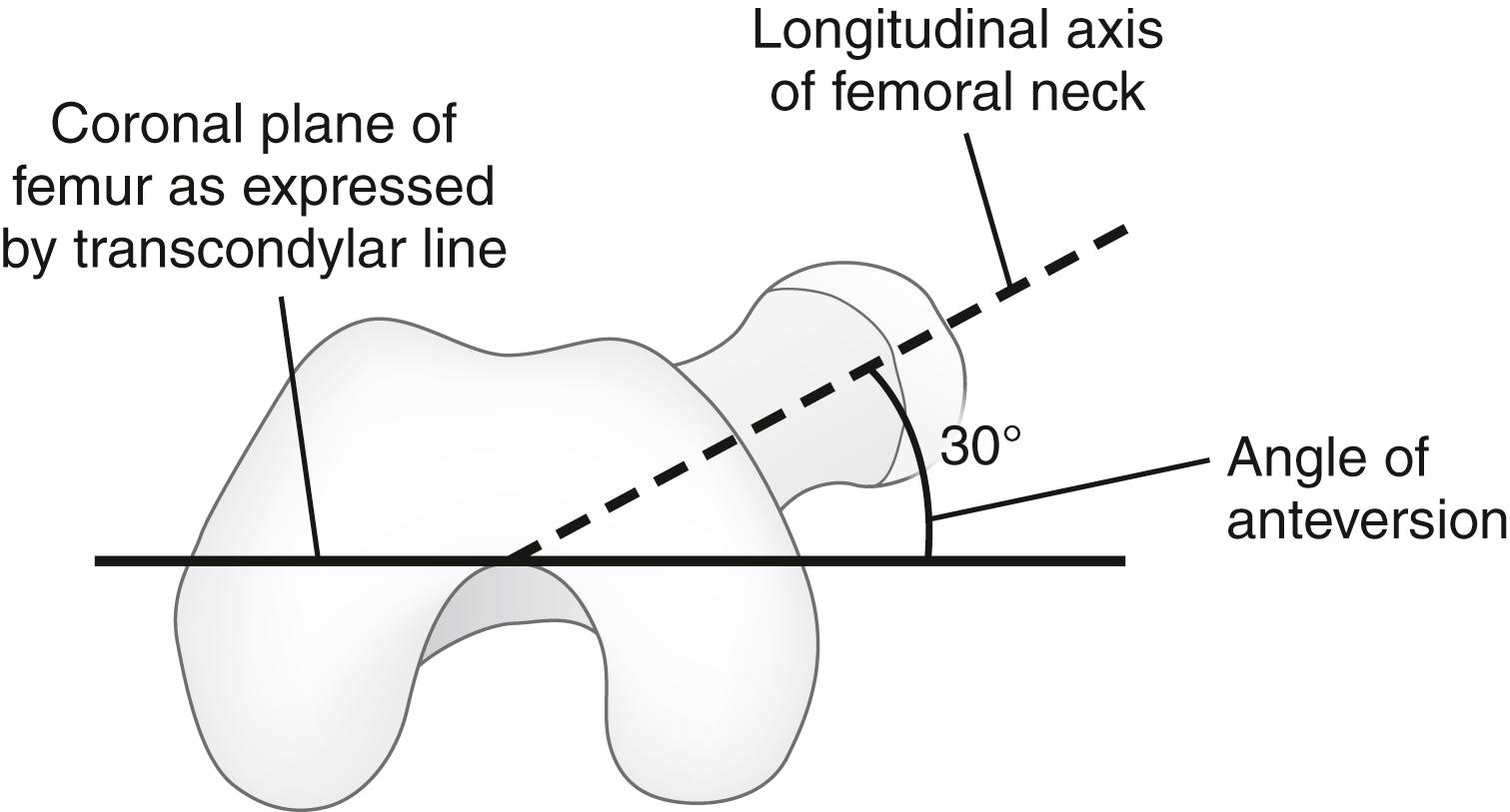
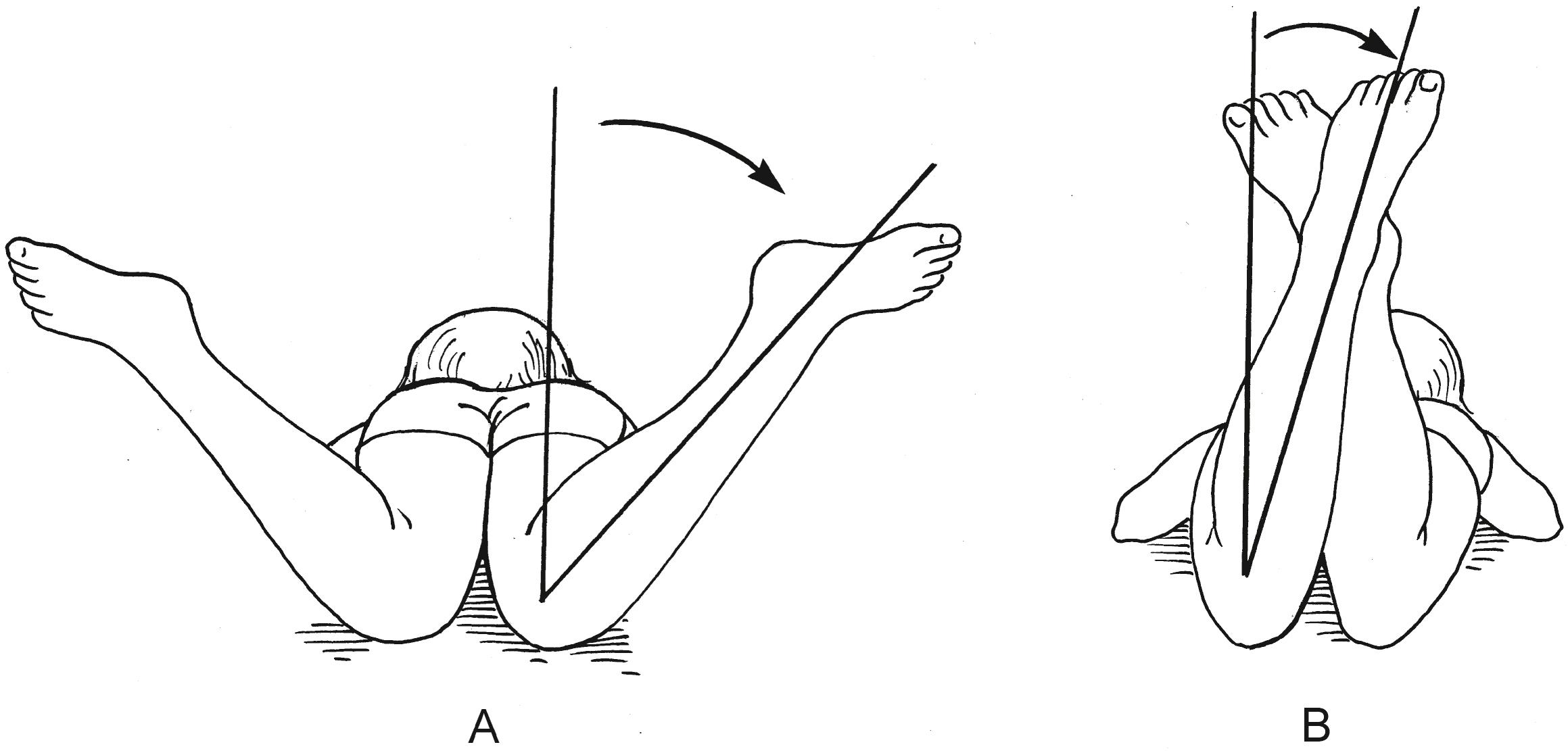
With the child in the prone position and the knees approximated and flexed 90 degrees, the long axis of the foot in the neutral or simulated weight-bearing position can be compared with the long axis of the thigh ( Fig. 45.6 ). Inward rotation is given a negative value, whereas outward rotation is given a positive value. Inward rotation is indicative of internal tibial torsion, and outward rotation represents external tibial torsion. This angle must be accurately measured and recorded. The mean thigh-foot angle is 10 degrees (range, −5 to +30 degrees) from middle childhood through adult life. Infants have a mean thigh-foot angle of −5 degrees (range, −35 to +40 degrees) as a consequence of the normal in utero position.
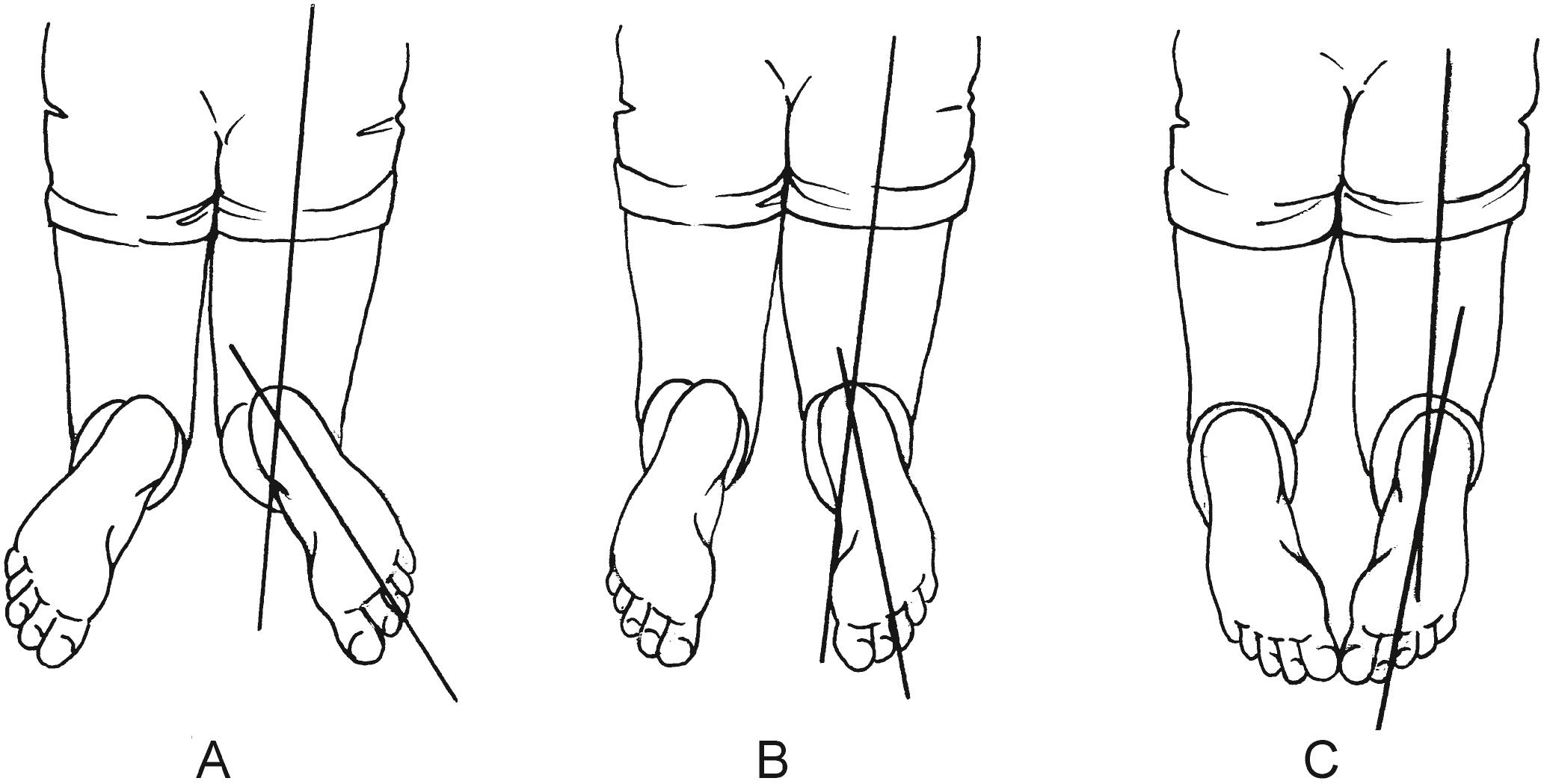
With the child again in the prone position, the shape of the foot is easily appreciated, allowing for assessment of children with metatarsus adductus or a calcaneovalgus foot. The mobility of the ankle and subtalar joint can also be evaluated with the child in this position.
Increased femoral anteversion, also referred to as internal femoral torsion, is the most common cause of in-toeing in children 3 years of age or older and occurs twice as often in girls as in boys. Many affected children have generalized ligamentous laxity . Increased femoral anteversion is secondary to excessive or persistent infantile femoral anteversion and is almost always a benign condition that typically improves by 8–9 years of age. Severe anteversion or lack of progressive improvement by late childhood warrants referral to an orthopedic surgeon.
Children with increased anteversion often run with a circumduction gait secondary to internal rotation at the hip, and the parents may note that the child W-sits rather than sitting cross-legged ( Fig. 45.7 ). W-sitting is of no concern developmentally, is the position of comfort for the child, and does not cause or worsen in-toeing in children. Children will typically stop sitting in this position after sufficient improvement in the internal torsion allows them to sit cross-legged more comfortably. Common femoral anteversion should not be viewed as a reason for decreased athletic ability or as a risk factor for arthritis, bunions, or back pain. A relationship with patellofemoral pain has been reported in some populations.
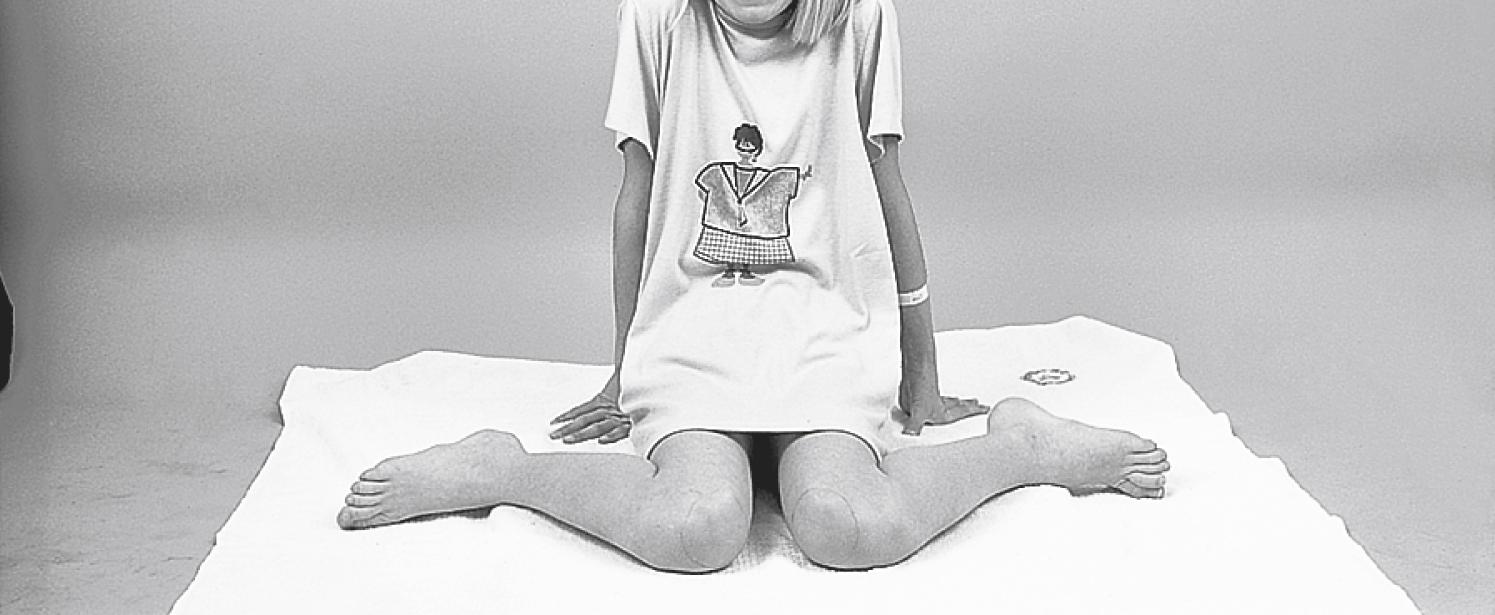
Gait assessment reveals that the entire lower extremity is inwardly rotated during ambulation. Foot progression angle is typically negative and a circumduction-type gait may be noted. Hip rotation assessment characteristically reveals 80–90 degrees of internal rotation in the prone, extended position ( Fig. 45.8 ). External rotation, as a consequence, is limited to 0–10 degrees. Features of generalized ligamentous laxity are often present, including elbow, wrist, and finger hyperextension; thumb hyperabduction; knee hyperextension; and hypermobile pes planus.
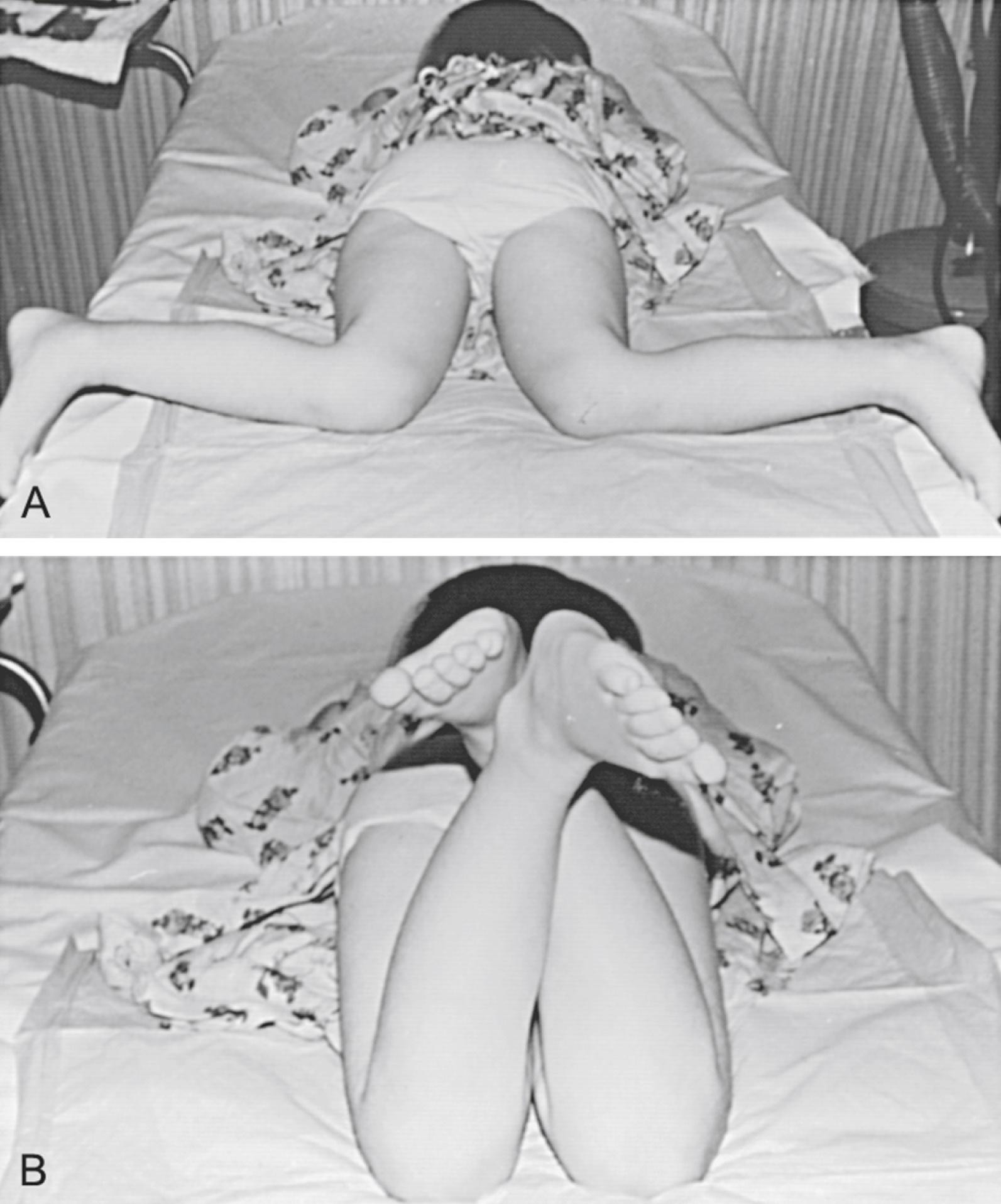
Radiographic evaluation of internal femoral torsion is not necessary. Anteroposterior radiographs of the pelvis are typically normal, but there may be the appearance of a relatively vertical femoral neck angle, or coxa valga. If coxa valga is noted, repeating the radiograph with the hips in 15 degrees of abduction and 30–40 degrees internal rotation will typically reveal a normal femoral neck angle. In more severe cases, MRI, CT, or ultrasonography of the proximal and distal femur can be used to accurately measure the degree of torsion.
Internal tibial torsion is the most common cause of in-toeing in children younger than 2 years and is secondary to normal in utero positioning. This condition is commonly seen during the second year of life and may be associated with metatarsus adductus. Significant improvement usually does not occur until the child begins to pull up to standing and walk independently. Spontaneous resolution with normal growth and development can be anticipated typically by 4–5 years of age. Rarely, persistent or severe internal tibial torsion in an older child or adolescent may necessitate surgical derotation.
The degree of tibial torsion can be assessed by measuring the thigh-foot angle (see Fig. 45.6 ). The measurements should be recorded on each visit to the physician to document improvement.
Radiographic evaluation of internal tibial torsion is not necessary. MRI and CT can assess the degree of tibial torsion, but these are rarely required.
Metatarsus adductus is the most common congenital foot deformity, occurs equally in boys and girls, and is bilateral in approximately 50% of cases. Metatarsus adductus has hereditary tendencies and is more common in first-born children, most likely as a result of increased molding from the more rigid primigravida uterus and abdominal wall. Up to 10% of children with metatarsus adductus have developmental dysplasia of the hip . Significant metatarsus adductus persisting or manifesting after 4 years of age may require surgical correction.
In metatarsus adductus, the forefoot is adducted and occasionally supinated, while the hindfoot and midfoot are normal. A visual line bisecting the heel should normally pass through the second toe or second web space; in metatarsus adductus this line intersects the forefoot more laterally. The lateral border of the foot is convex, the base of the fifth metatarsal is prominent, and the medial border of the foot is concave. There is usually an increased interval between the first and second toes, with the great toe being held in an inwardly rotated or varus position ( Fig. 45.9 ). Ankle range of motion is normal. Forefoot mobility, assessed by stabilizing the hindfoot and midfoot in a neutral position and applying pressure over the first metatarsal head with the opposite hand, can vary from flexible to rigid. Most cases of flexible metatarsus adductus resolve by several months of age; rigid deformities may require casting or surgical correction. In the walking child with an uncorrected or partially corrected metatarsus adductus, there is an in-toed gait, abnormal shoe wear, and possible discomfort from shoe pressure.
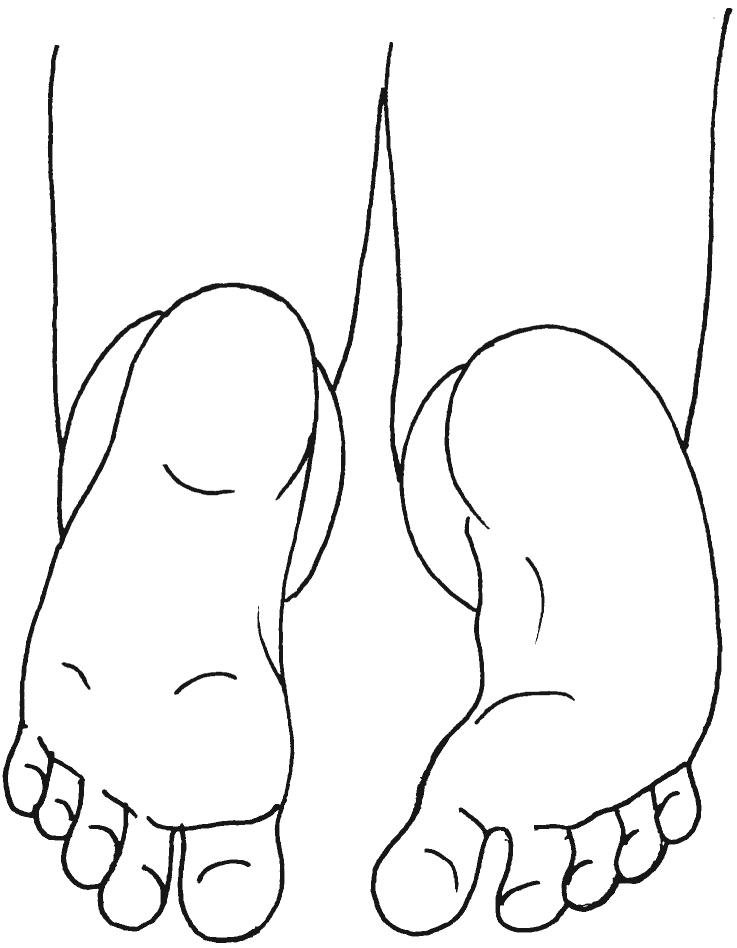
Radiographs of the foot are not necessary for routine, flexible metatarsus adductus. When obtained, anteroposterior and lateral weight-bearing radiographs demonstrate adduction of the metatarsals at the tarsometatarsal joint and an increased intermetatarsal angle between the first and second metatarsals. The midfoot and hindfoot are usually normal. Radiographs should be obtained if the deformity is rigid or if there are any suspected abnormalities of the midfoot or hindfoot.
Talipes equinovarus is classified as either positional or congenital. Positional clubfoot is a normal foot that has been held in the deformed position in utero, and which is flexible on examination in the newborn nursery. Congenital clubfoot represents a deformity not only of the foot but also of the entire lower leg and is categorized as either idiopathic or syndromic. There is a spectrum of severity, but clubfoot associated with neuromuscular diagnoses or syndromes is typically rigid and more difficult to treat. Clubfoot is also extremely common in patients with spinal dysraphism, arthrogryposis, and chromosomal syndromes such as trisomy 18 and chromosome 22q11.2 deletion syndrome.
Congenital clubfoot, when diagnosed and treated in infancy with serial casting, typically does not produce a gait disturbance. However, foot contact pressures may remain high, indicating that gait is not entirely normal following correction. In-toeing secondary to persistent internal tibial torsion is common after appropriate treatment. A mild lower extremity length discrepancy of up to 2 cm may be seen in adolescence but usually does not produce a limp or necessitate treatment. On occasion, residual muscle imbalance may cause the child to walk on the lateral border of the foot, leading to discomfort and an antalgic gait that may require further surgical correction.
Femoral retroversion, also referred to as external femoral torsion, is a rare disorder that usually causes no significant functional impairment unless it is associated with a slipped capital femoral epiphysis (SCFE) . If the femoral retroversion is caused by SCFE, the slip is treated surgically. On occasion, persistent femoral retroversion following surgical treatment of SCFE can lead to ongoing functional impairment, such as a severe out-toed gait and difficulty in approximating the knees in the sitting position, and may require further surgical correction.
Children with external femoral torsion demonstrate limited internal rotation and excessive external rotation when the hip is examined in the extended position. The hip externally rotates 70–90 degrees, whereas internal rotation is only 0–20 degrees. Idiopathic external femoral torsion is usually bilateral. If the deformity is unilateral, especially in an obese older child or a young adolescent, SCFE must be considered and evaluated.
Anteroposterior and frog-leg lateral radiographs of the pelvis are necessary for any child or adolescent presenting with external femoral torsion, especially one who is obese, has atraumatic or referred anterior thigh or knee pain, or has unilateral deformity. Approximately 20% of children with SCFE have simultaneous bilateral involvement. The typical changes of SCFE include widening of the physis and an abnormal relationship between the capital femoral epiphysis (CFE) and the femoral neck. The femoral head appears to be slipped inferiorly and posteriorly, but in actuality, the femoral neck is displaced anteriorly and superiorly.
External tibial torsion is common and is secondary to a normal variation of in utero positioning in which the plantar surface of the foot is against the wall of the uterus, forcing it into a hyperdorsiflexed, everted position. This rotated alignment produces external tibial torsion and typically an associated calcaneovalgus foot ( Fig. 45.10 ). When this alignment of the lower leg and foot is combined with the exaggerated external rotation of the normal newborn hip, the lower extremity appears to have severe out-toeing and external rotation. This condition follows the same clinical course as internal tibial torsion in that significant improvement does not occur during the first year of life. With the onset of independent ambulation, spontaneous improvement begins and is typically complete by 2–3 years of age.
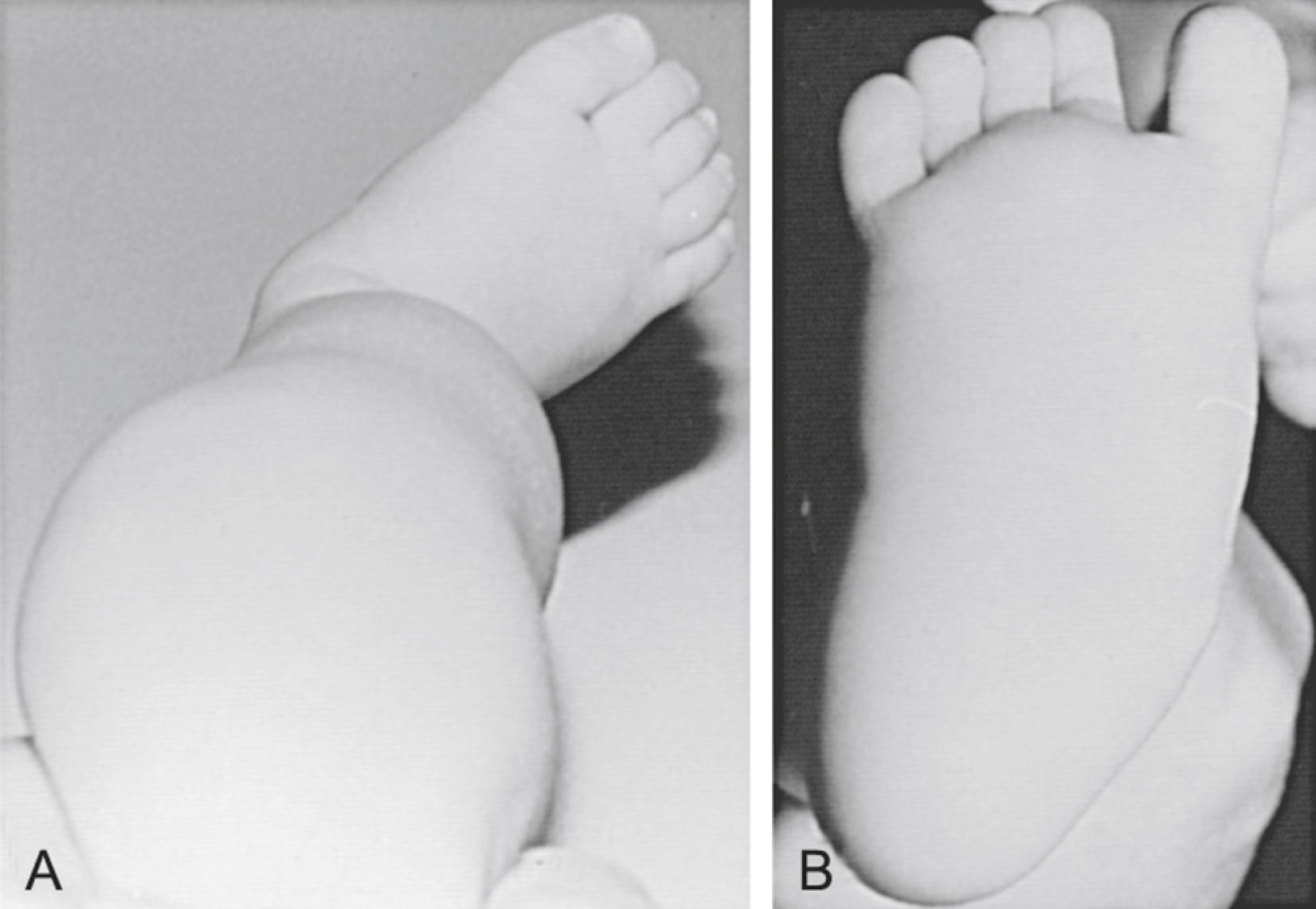
External tibial torsion results in a positive thigh-foot angle of 30–50 degrees.
Radiographic assessment for external tibial torsion is not necessary.
The calcaneovalgus foot is common in newborns and is secondary to in utero positioning (see Fig. 45.10 ). The foot is hyperdorsiflexed with varying degrees of eversion and forefoot abduction. External tibial torsion is usually present. Calcaneovalgus foot is typically unilateral but may occasionally be bilateral. The hyperdorsiflexion of the foot usually resolves during the first 3–6 months of life. On occasion, resistant feet may require passive stretching, taping, or casting into a plantarflexed position. Usually, by the time the child begins to pull to standing and walk independently, the calcaneovalgus condition has resolved. The external tibial torsion, however, persists and follows the same natural history as internal tibial torsion.
Become a Clinical Tree membership for Full access and enjoy Unlimited articles
If you are a member. Log in here